Research News
- Facial recognition system August 23, 2022
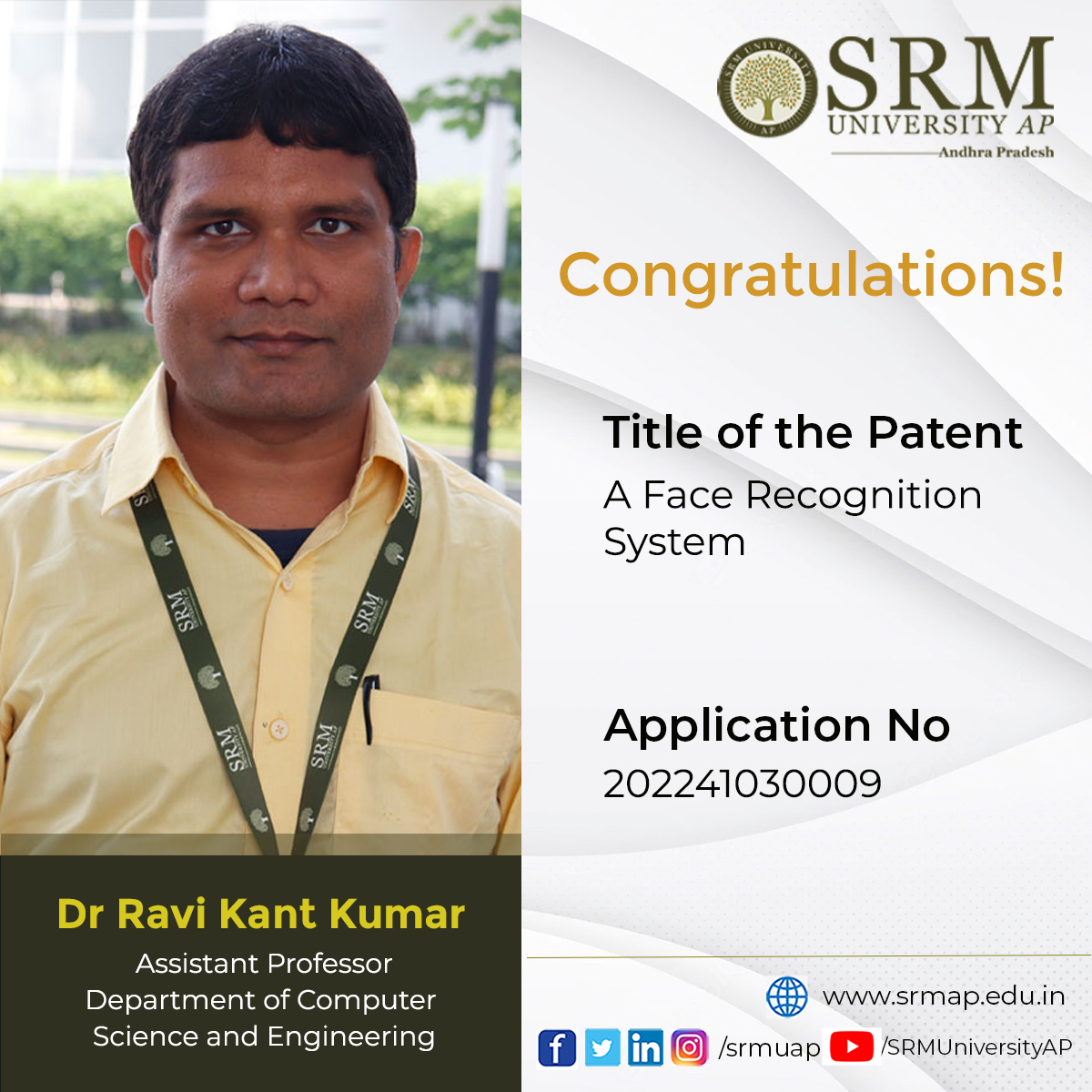 Assistant Professor Dr Ravi Kant Kumar of the Department of Computer Science and Engineering aspires to investigate and design the most effective face recognition system appropriate enough to recognise faces in various unconstraint environments. Recently, his patent application titled A Face Recognition System (Application number: 202241030009) got published. He collaborated with his BTech student Thota Venkata Saai Praneeth, for this project. Facial recognition systems have abundant applications in Face Identification, Automobile Security, Access Control, Immigration, Education, Retail, Healthcare, Image database investigations, Surveillance, and many more.
Assistant Professor Dr Ravi Kant Kumar of the Department of Computer Science and Engineering aspires to investigate and design the most effective face recognition system appropriate enough to recognise faces in various unconstraint environments. Recently, his patent application titled A Face Recognition System (Application number: 202241030009) got published. He collaborated with his BTech student Thota Venkata Saai Praneeth, for this project. Facial recognition systems have abundant applications in Face Identification, Automobile Security, Access Control, Immigration, Education, Retail, Healthcare, Image database investigations, Surveillance, and many more.Abstract
A facial recognition system is used for matching a human face captured in an image or a video frame with a database of faces. The system generally authenticates users by measuring facial features from the stored images. The present disclosure relates to face recognition systems. The envisaged system comprises a repository comprising a set of facial images of a plurality of subjects, a set of threshold values, and a plurality of rules. The system further comprises an image capturing unit for capturing a plurality of images of a subject’s face. A segmentation unit divides each image into a plurality of frames. The system further comprises a classifier that receives the frames and classifies frames containing faces from frames containing non-faces from the other frames. The facial features of each frame are extracted by an extractor. An analyser receives the extracted facial features and computes eigenvector values of the facial features of the frame. A comparator compares the computed eigenvector values with threshold values using the comparison rules to identify the subject.
Explanation of the research
Conventional facial recognition systems are configured to identify the contours of a person’s image captured by a camera or in real-time and compare it with the stored image to identify the person. However, external factors such as position, light conditions, camera calibration, and unconstraint conditions, among others, affect the identification of the face of the subject. Hence, comparing the faces with the help of the contours is not reliable. The present disclosure envisages a face recognition system. The system comprises a repository, an image capturing unit, a segmentation unit, a classifier, an extractor, an analyser, and a comparator. The repository consists of a set of facial images of a plurality of subjects, wherein the images define the subject’s facial features in different facial poses. Each image is tagged with an identity, a threshold integral value, and threshold eigenvector values corresponding to the facial features. The repository further comprises a first set of deep learning rules for classifying frames of a captured image into frames containing faces and frames containing non-faces, a set of extraction rules for extracting facial features from the frames 20 containing faces, the second set of deep learning rules for extracting eigenvector values of facial features of the frames containing faces. The repository additionally comprises a set of comparison rules for comparing eigenvector values of the captured facial features with the stored threshold eigenvector values to identify a subject’s face in the captured image.
- Systematic bibliographic research on eutrophic-ecological models August 22, 2022
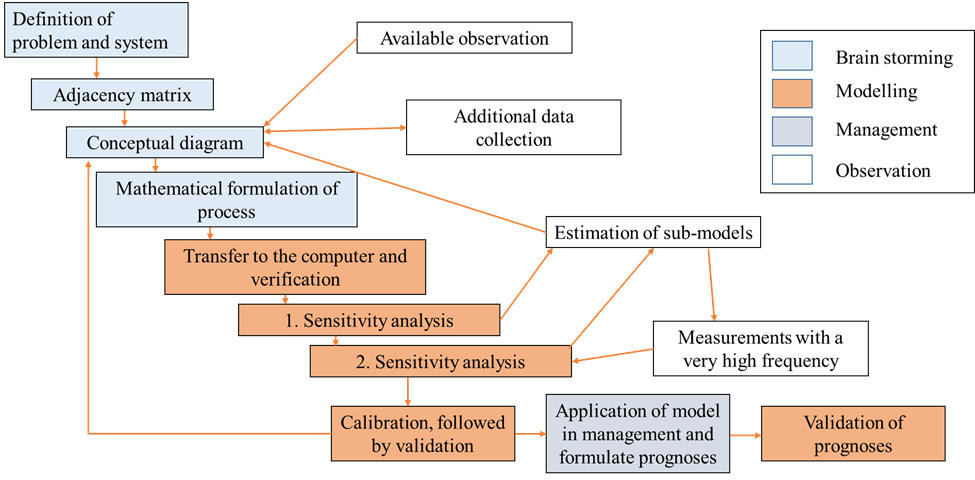
The Department of Civil Engineering is delighted to announce that Dr Siddhant Dash has published a paper titled “Systematic bibliographic research on eutrophication-based ecological modelling of aquatic ecosystems through the lens of science mapping” in the journal “Ecological Modelling” having an Impact Factor of 3.512. This research was conducted in collaboration with Prof Ajay S Kalamdhad from IIT Guwahati.
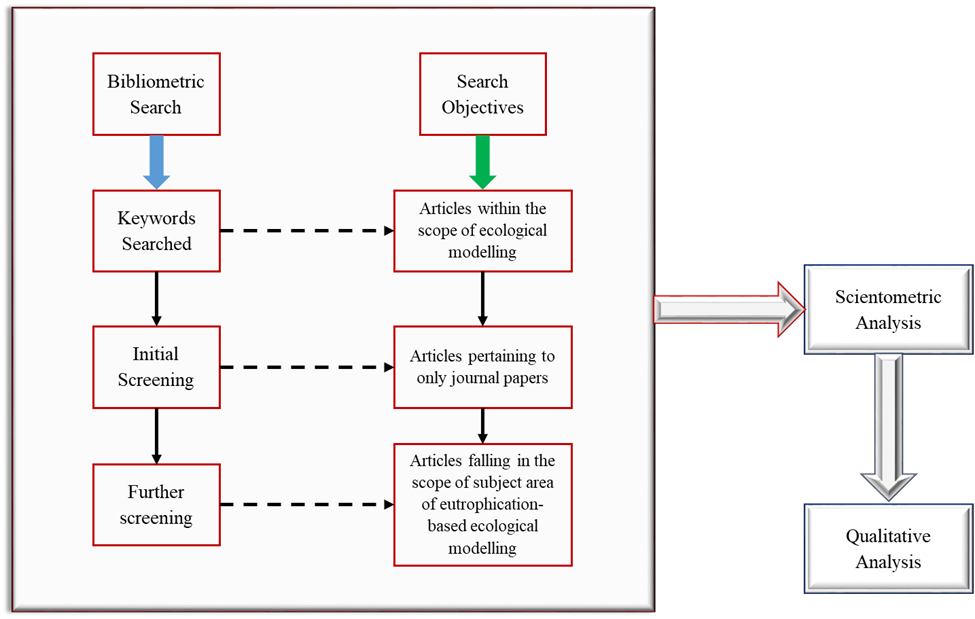
This research is a systematic approach on reviewing the published literature on eutrophic-ecological models developed worldwide and the methods associated with them. This provides critical insights into the status of the research domain, thereby providing a direction for the practising and future researchers to undertake a research career in this domain. It offers a more comprehensive and holistic approach to the critical review of the published literature, providing a deeper understanding to the researchers regarding the existing practices of developing eutrophication-based ecological models and the prospects lying ahead. His future research plans include understanding carbon and nutrient dynamics within an aquatic ecosystem.
Abstract of the Research
When water bodies receive surplus nutrients, especially nitrates and phosphates, these nutrients stimulate excessive plant growth (eutrophication), including harmful algal blooms, leading to oxygen depletion, decreased biodiversity, changes in species composition and dominance, and degradation of water quality. Although there are natural causes, much of the eutrophication today results from inadequately treated wastewater and agricultural runoffs. Population pressure, urbanization and industrialization contribute a considerable amount of waste, which alters the physio-chemical quality of water that eventually upsets the biotic components of the aquatic system. It is important to note that though pollution has been a significant factor in degrading the quality of aquatic ecosystems, the lack of management and global awareness regarding the protection and conservation of water bodies worldwide cannot be neglected. Hence, there lies an inherent sense of responsibility to restore the aquatic ecosystems to their natural state. Numerous techniques/treatment options are available for varying conditions, such as climatic factors, socio-economic factors, and so on. However, before ascertaining a treatment alternative to curb eutrophication levels, understanding the dynamics of any independent aquatic ecosystem is of prime importance. This necessitates a reliable model, which can provide information regarding the physical processes and dynamic occurrences in the eutrophic water bodies. Ecological modelling refers to the formation of dynamic and complex relationships between the organisms found in the ecosystem and the surrounding. It attempts to unravel the effects of certain relationships in the ecosystem that are not so apparent at first glance. The present study provides a scientific investigation of a detailed review of the published works in the domain of eutrophication-based ecological modelling till the year 2020. The first step was the scientometric studies, which were followed by a qualitative assessment wherein the current trends in research were discussed. This was followed by identifying the critical gaps in research to provide future direction.
Fig. 1. Ecological modelling process
Fig. 2. Description of the three-step literature review process employed in this research
Continue reading → - Effect of grass clippings on anaerobic co-digestion of food waste August 22, 2022
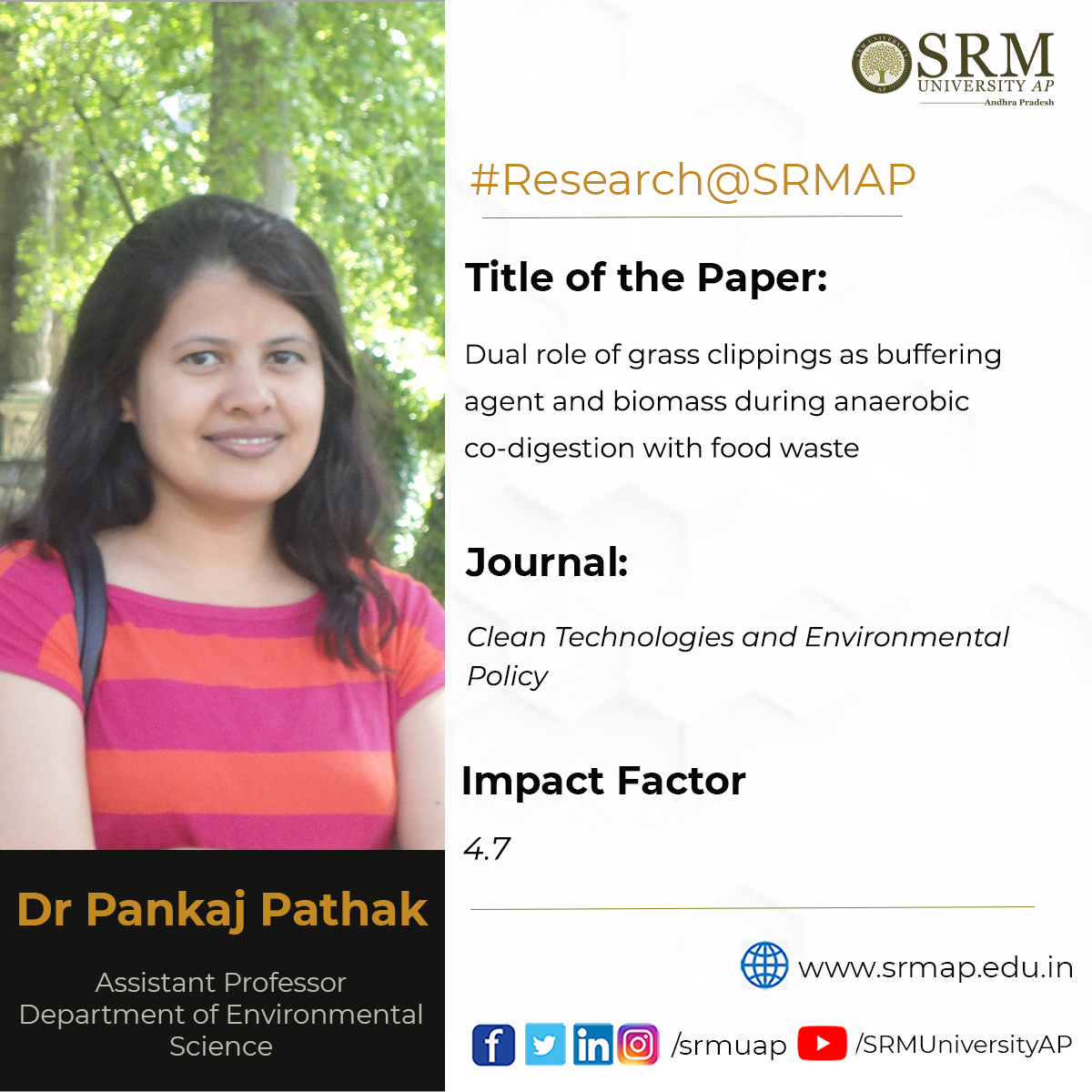 The different dimensions of sustainable waste management have always been explored by researchers all over the world. Assistant Professor Dr Pankaj Pathak, Department of Environmental Science, has been actively involved in this research area for a while. Her paper titled Dual role of grass clippings as buffering agent and biomass during anaerobic co digestion with food waste is published in the journal Clean Technologies and Environmental Policy with an impact factor 4.7. Dr Pankaj Pathak co-authored the paper with Debkumar Chakraborty, Sankar Ganesh Palani, M M Ghangrekar, and N Anand.
The different dimensions of sustainable waste management have always been explored by researchers all over the world. Assistant Professor Dr Pankaj Pathak, Department of Environmental Science, has been actively involved in this research area for a while. Her paper titled Dual role of grass clippings as buffering agent and biomass during anaerobic co digestion with food waste is published in the journal Clean Technologies and Environmental Policy with an impact factor 4.7. Dr Pankaj Pathak co-authored the paper with Debkumar Chakraborty, Sankar Ganesh Palani, M M Ghangrekar, and N Anand.Abstract
There is a dire need to replace the chemical buffers that regulate the redox environment in single-stage anaerobic digestion of food waste. Hence, the applicability of grass clippings as an eco-friendly buffering agent and biomass during the anaerobic co-digestion of food waste was explored. A focus was primarily given on the effects of grass clippings on the redox environment and acidogenesis. Concomitantly the production of volatile fatty acids, hydrogen, and methane in mesophilic conditions was monitored. Organic load and substrate-to-inoculum ratio were kept constant in all the experiments, and no chemical buffer was used. The results revealed that the redox environment was regulated with 10% grass clippings by inhibiting rapid pH drop in the digester. The addition of 2, 4, and 6% grass clippings promoted acidogenesis with increased production of acetic and butyric acids, whereas 8 and 10% grass clippings promoted solventogenesis with ethyl alcohol production. Hydrogen generation from the experiments with grass clippings was in the range of 27–30% of the total biogas, which was marginally higher than the control (25%). Methane concentration was negligible in the biogas generated from all experiments. The acidification rate, VFA production/consumption rate, specific hydrogen yield, hydrogen conversion efficiency, and volatile solids removal were maximum and minimum in the reactors with 6 and 10% grass clippings, respectively. From the above results, it can be concluded that adding grass clippings to food waste would regulate the sudden pH changes and enhance the production of value-added biochemicals, making the process cost-effective.
Continue reading → - The prospects and challenges in India-ASEAN relations August 22, 2022
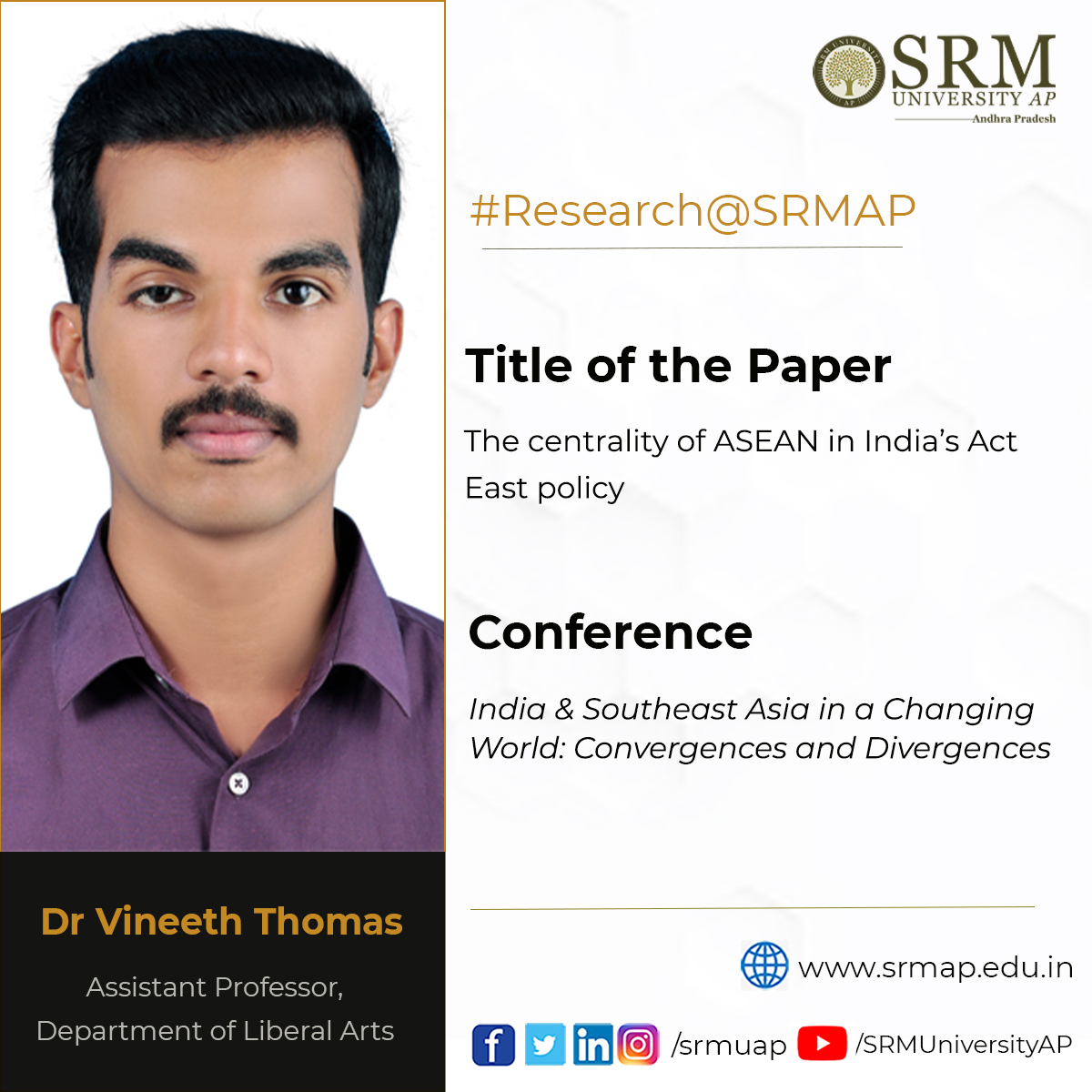 The upcoming international conference, India & Southeast Asia in a Changing World: Convergences and Divergences, will examine India’s Act East policy, investigating its prospects and challenges in the Southeast Asian region. Assistant Professor Dr Vineeth Thomas from the Department of Liberal Arts has been selected for presenting a paper at this Conference organised by Christ University, Delhi NCR. He will present the paper titled The centrality of ASEAN in India’s Act East policy at the conference.
The upcoming international conference, India & Southeast Asia in a Changing World: Convergences and Divergences, will examine India’s Act East policy, investigating its prospects and challenges in the Southeast Asian region. Assistant Professor Dr Vineeth Thomas from the Department of Liberal Arts has been selected for presenting a paper at this Conference organised by Christ University, Delhi NCR. He will present the paper titled The centrality of ASEAN in India’s Act East policy at the conference.The international conference will be held In-Person from 14 to 15 October 2022 at the CHRIST (Deemed to be University) Delhi-NCR campus. The Hanns Seidel Foundation funds this conference. The major focus area of the conference is India’s foreign policy towards ASEAN countries like Myanmar, Thailand, Malaysia, Vietnam, Indonesia, and Singapore
Abstract
Against the backdrop of multi-dimensional developments and interventions in the Indo-Pacific region, India’s overseas policy and national security apprehensions have undergone substantial changes in the past few decades. Starting with the Look East Policy in the 1990s, India advanced its policy in 2014 as Act East Policy. The potential benefits of bilateral and multilateral relations in the Indo-pacific region made India take up its partnership with the Association of Southeast Asian Nations (ASEAN) seriously, which provided an opening and strip for India to explore Southeast Asia. This paper evaluates the significance of keeping ASEAN at the heart of India’s Act East Policy by illustrating the prospects and challenges in India-ASEAN relations.
Continue reading → - Prediction of breakdown in disordered solids August 11, 2022

The Department of Physics is glad to announce that Assistant Professor Dr Soumyajyoti Biswas and his PhD scholar Ms Diksha have published their article “Prediction of imminent failure using supervised learning in a fiber bundle model” in the Q1 journal, Physical Review E. Prediction of breakdown in disordered solids under external loading is a question of paramount importance to the stability of buildings and bridges to earthquakes. The researchers used numerical simulations of a model of disordered solids and recorded the time series of the avalanche sizes and energy bursts. They propose that a systematic analysis of these time series using supervised machine learning can predict the time of failure. Interestingly, the most important feature for such predictions turns out to be the measures of how unequal the avalanche sizes are.
Applying external stress on disordered materials beyond their mechanical limits results in their fracture. Hence it is important to know the limit or how the material behaves as it approaches the limit and the factors that influence it. The failure properties of materials are very distinct from other properties such as elasticity, in the sense that their predictions are not always straightforward. Predicting the failure in driven disordered systems is a long-standing problem in physics, engineering, and earth sciences. So, for understanding the fracture process and predicting the failure properties of the materials, a mathematical model (fibre bundle model) has been used.
They introduced the disorder to the system and generated the time series of avalanche size and energy bursts. Some inequality indices i.e., Hirsch index (h), Gini index (g) and recently introduced Kolkata index (k) were measured for the response statistics of the driven systems. These social inequalities are usually represented by the Lorenz function L(p), where p fraction of the population (events) possesses L(p) fraction of total wealth (avalanche mass) when the population (avalanche events) are arranged in the ascending order of their wealth (size). Based on these time series, the machine learning algorithm can predict the prior failure time of the system. So, they have used a supervised machine learning algorithm (with the above-mentioned indices as some of the features) to predict the failure time of the model. They observed that these inequality measures play an important role in making predictions.
Prediction of imminent fracture has its implications in a wide range of disciplines, including stability of mechanical structures (buildings, aircraft, bridges etc.), extraction of oil (fracking) to the largest scale of mechanical failure i.e., earthquakes. Here a supervised machine learning approach is used to make such predictions in numerical models. However, with the important features identified here for such predictions, such research can carry out similar predictions for experimental data. A follow-up of this work is being carried out by Ms Diksha with a group in Spain regarding the experimental verification. Their future research plans include applications of the methods developed here to be applied to real-life physical structures for their stability analysis and predictions of impending catastrophes.
Illustration 1: A schematic diagram of the Lorenz function L(p)is shown, where L(p) denotes the cumulative fraction of the avalanche mass contained in the smallest p fraction of avalanches. If all avalanches were equal in size, this would be a diagonal straight line, called the equality line. The area between the equality line and the Lorenz curve (shaded area),therefore, is a measure of the inequality in the avalanche sizes. Two quantitative measures of such inequality are extracted from here, the ratio of the shaded area and that under the equality line (Gini index, g) and the crossing point of the opposite diagonal – from (0,1) to (1,0), shown in dashed line,and the Lorenz curve, giving the Kolkata index, k. 1 − k fraction of avalanches contain k fraction of the cumulative avalanche mass.
Continue reading → - Energy efficient MIMO-NOMA aided IoT network in B5G communications August 8, 2022
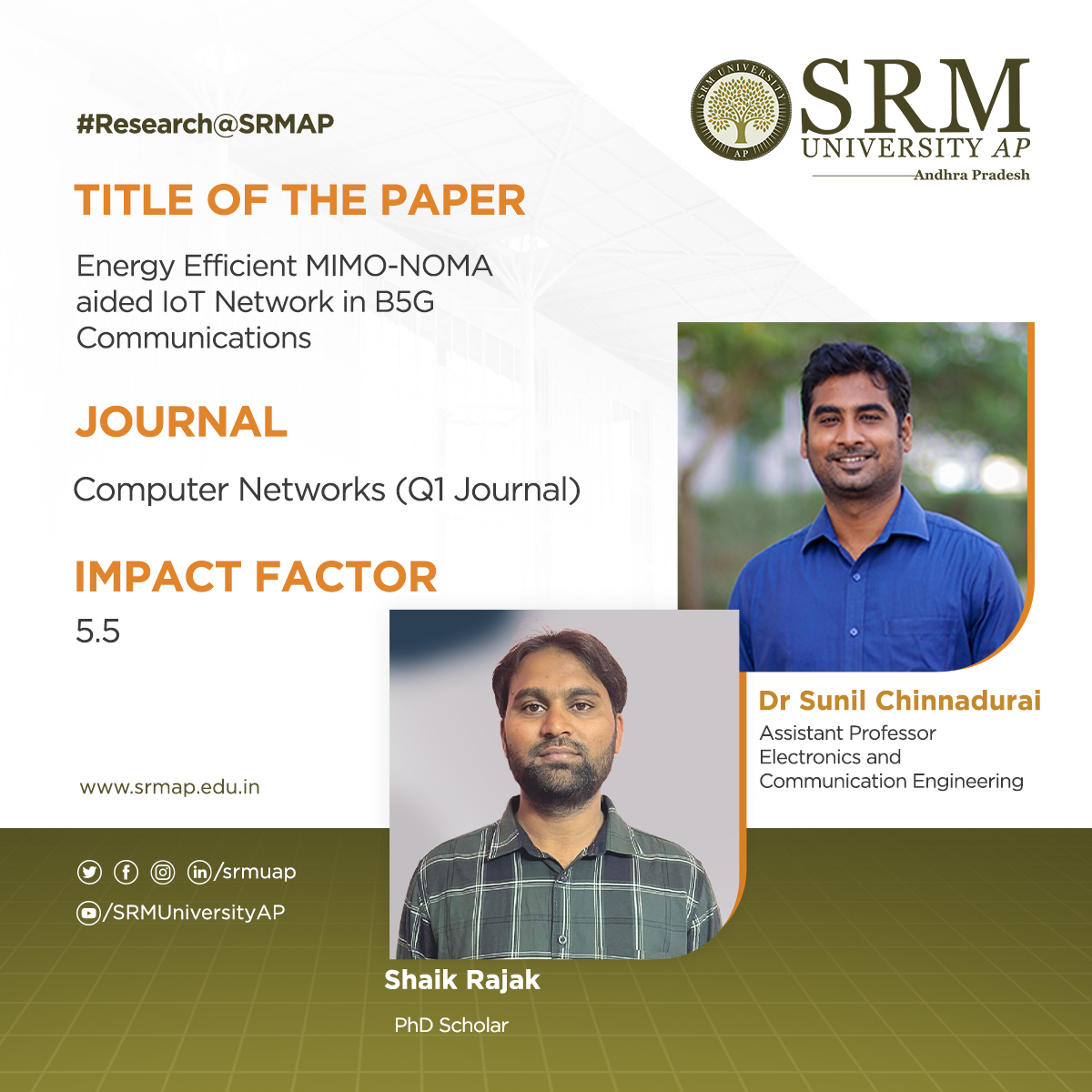
The Department of Electronics and Communication Engineering is glad to announce that Assistant Professor Dr Sunil Chinnadurai and his research scholar Mr Shaik Rajak have published a paper titled “Energy Efficient MIMO-NOMA aided IoT Network in B5G Communications” in the Q1 journal Computer Networks having an Impact Factor of 5.5. With an intent to accelerate the development of future intelligence wireless systems, the paper proposes an energy-efficient massive multiple-input-multiple-output (MIMO)- non-orthogonal multiple access (NOMA) aided internet of things (IoT) network to support the massive number of distributed users and IoT devices with seamless data transfer and connectivity.
Abstract of the research
Massive MIMO has been identified as a suitable technology to implement the energy efficient IoT network beyond 5G (B5G) communications due to its distinct characteristics with a large number of antennas. However, providing fast data transfer and maintaining hyperconnectivity between the IoT devices in B5G communications will bring the challenge of energy deficiency. Hence, they considered a massive MIMO-NOMA aided IoT network considering imperfect channel state information and practical power consumption at the transmitter. The far users of the base stations are selected to investigate the power consumption and quality of service. Then, they calculated the power consumption which is a non-convex function and non-deterministic polynomial problem. To solve the above problem, fractional programming properties are applied which converted the polynomial problem into the difference of convex function. And then they employed the successive convex approximation technique to represent the non-convex to convex function. Effective iterative-based branches and the reduced bound process are utilized to solve the problem. Numerical results observed that their implemented approach surpasses previous standard algorithms on the basis of convergence, energy efficiency, and user fairness.
Explanation of the research in layman’s terms
- A cost-effective (i.e., energy efficient) maximization problem for the multiple cells NOMA heterogeneous network scheme is explored when meeting the transmission power and data necessity of far users. The singular value uncertainty model (SVUM) is deliberated to add the errors with the transmitted signal. Since it’s a non-convex problem and challenging to solve, they used the properties of fractional programming to convert it into its corresponding mathematical terms. ITS needs higher data rate and seamless connectivity to operate with maximum speed and safety.
- SCA methods are then applied to change the optimisation problem. After that, an effective iterative scheme is employed based on Branch and Reduced Bound (BRB) that resolves the energy-efficient SVUM problem and satisfies the convergence criteria.
- The proposed iterative BRB method enhances user fairness and decreases inter-tier interference (ITI). IRS has been recognised as the key enabling technology to provide the data required by the ITS with less power consumption.
- Energy efficiency achieved by the proposed BRB method is examined with the help of numerical results and found that the proposed algorithm provides better efficacy than the majorisation minimisation (MM) method and the well-known OMA scheme.
Practical implementations of the research
- To provide high data rates to wireless sensors and the internet of things (IoT), future communication systems can ultimately be advanced by implementing NOMA, small cell, and heterogeneous networks (HetNets) along with MIMO.
- An energy-efficient massive MIMO-NOMA aided IoT network to support the massive number of distributed users and IoT devices with seamless data transfer and connectivity between them in B5G communications.
Future research plans
- To explore the energy efficiency of AI-driven IoT networks for applications such as intelligent health care and intelligent vehicular communications.
- MIMO-NOMA with IRS elements to reduce power consumption and improve the connectivity between the users.
- Charge transfer in photoexcited cesium lead halide perovskite nanocrystals August 8, 2022

The Department of Chemistry is glad to announce that Assistant Professor Dr Nimai Mishra and his research group Manoj Palabathuni, Syed Akhil, and Rahul Singh have published an article titled “Charge Transfer in Photoexcited Cesium Lead Halide Perovskite Nanocrystals: Review of Materials and Applications” in the Q1 journal “ACS Applied Nano Materials ” published by The American Chemical Society. The journal has an Impact Factor of 6.14.
Cesium Lead Halide (CsPbX3) perovskite nanocrystals (PNCs) have attracted significant views from researchers due to their essential optoelectronic properties, especially long charge carrier transfer, high efficiency in visible light absorption, and long excited states lifetime, etc. Because of these properties, these materials exhibit outstanding charge transfer and charge separation, which enables them for solar cell applications. Recently, cesium lead halide perovskites have emerged as photocatalysts. In photovoltaics or photocatalysis, upon photoexcitation, the exciton dissociates, and the electron/hole is transmitted from the conduction/valance bands to the electron/hole acceptors. Therefore, it is essential to understand how the charge transfer occurs at the PNCs interface, which can help the researcher maximize the output in solar cells and photocatalytic efficiency.
In this article, Dr Mishra’s research group has outlined different charge transfer dynamics based on critical factors and discussed their optoelectronic properties. Electron/hole transfer dynamics are the most concerning characteristic; thus, they reviewed the relevant literature that reported efficient electron/hole transfer performance. In the end, they highlighted the recent development of the use of perovskite nanocrystal as photocatalyst in organic synthesis.
Continue reading → - Sustainable strategies for solid waste management August 5, 2022
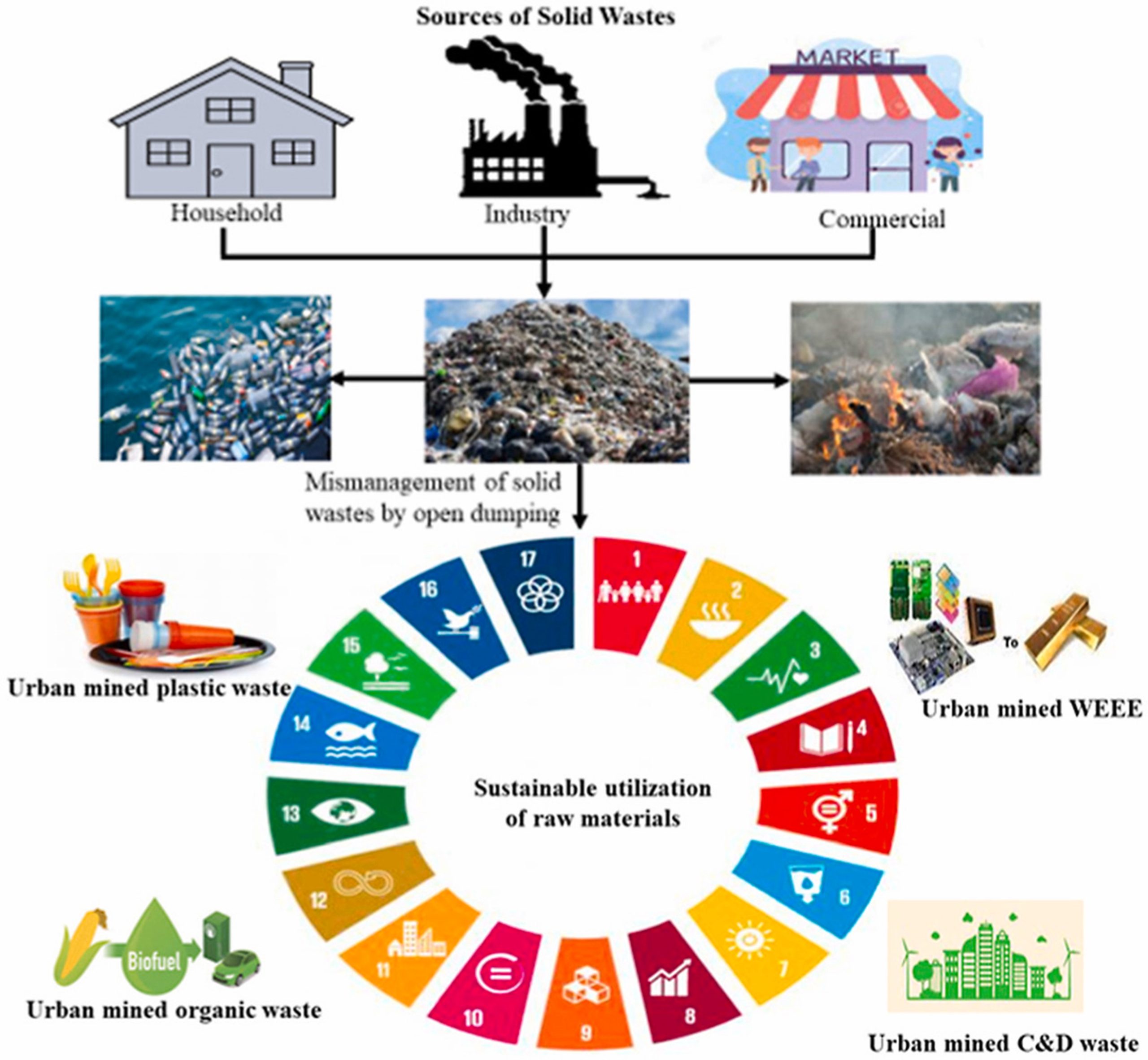 Dr Pankaj Pathak from the Department of Environmental Science has been keenly involved in research studies involving solid waste management and the effective conversion of wastes to energy. Her latest research publication Sustainable approach for valorization of solid wastes as a secondary resource through urban mining proposes an enhanced solution for the sustainable management of different types of solid wastes. It was published in the Journal of Environmental Management with an impact factor 8.98.
Dr Pankaj Pathak from the Department of Environmental Science has been keenly involved in research studies involving solid waste management and the effective conversion of wastes to energy. Her latest research publication Sustainable approach for valorization of solid wastes as a secondary resource through urban mining proposes an enhanced solution for the sustainable management of different types of solid wastes. It was published in the Journal of Environmental Management with an impact factor 8.98.In this paper, sustainable alternative valorisation techniques that aid in maximum recovery from waste materials, and associated challenges and limitations have been highlighted. These solid wastes mainly include construction and demolition wastes, organic food wastes, plastic, and WEEE (Waste electrical and electronic equipment) from various sources. In order to overcome these challenges, a sustainable circular model is recommended in this paper that will help minimise the negative environmental impacts, maximise the life cycle of material, reduce the consumption of fossil fuels, and thereby sustainably manage waste. Implementation of this recommendation can help in achieving the target of sustainable development goals (SDGs).
The article was published in collaboration with her PhD Scholar MSSR Tejaswini, and D.K. Gupta, Member Secretary in the Hazardous Substance Management Division in the Ministry of Environment, Forest and Climate Change, New Delhi.
Abstract
The incessant population has increased the production and consumption of plastics, paper, metals, and organic materials, which are discarded as solid waste after their end of life. The accumulation of these wastes has created growing concerns all over the world. However, conventional methods of solid waste management i.e., direct combustion and landfilling have caused several negative impacts on the environment (releasing toxic chemicals and greenhouse gases, huge land use) besides affecting human health. Therefore, it is requisite to determine sustainable alternative technologies that not only help in mitigating environmental issues but also increase the economic value of the discarded solid wastes. This process is known as urban mining where waste is converted into secondary resources and thereby conserves the natural primary resources. Thus, this review highlights the technological advancements in the valorisation process of discarded wastes and their sustainable utilization. We also discussed several limitations of the existing urban mining processes and further the feasibility of valorisation techniques was critically analysed from a techno-economical perspective. This paper recommends a novel sustainable model based on the circular economy concept, where waste is urban mined and recovered as a secondary resource to support the united nations sustainable development goals (SDGs). The implementation of this model will ultimately help the developing countries to achieve the target of SDGs 11, 12, and 14.
- Combining intelligent systems for social good August 5, 2022
 Merging the calibre of two well-fledged technologies will massively impact the momentum of social life. Decoding the possible links between promising technologies would employ solutions to various societal issues. Dr Ashok Kumar Pradhan, Associate Professor of the Department of Computer Science and Engineering, gave life to this thought by publishing a book titled Intelligent Systems for Social Good Theory and Practice. He published this work as an editor in a book series named Advanced Technologies and Social Change by Springer Nature.
Merging the calibre of two well-fledged technologies will massively impact the momentum of social life. Decoding the possible links between promising technologies would employ solutions to various societal issues. Dr Ashok Kumar Pradhan, Associate Professor of the Department of Computer Science and Engineering, gave life to this thought by publishing a book titled Intelligent Systems for Social Good Theory and Practice. He published this work as an editor in a book series named Advanced Technologies and Social Change by Springer Nature.The book highlights the connection between the two technologies: Artificial intelligence (AI) and the Internet of Things (IoT). It shows the better impact of the relation between these technologies in society, using real-world examples. Each chapter in the book proposes novel solutions to societal problems along with the challenges in the application of AI and IoT to solve them. The adverse attacks on Machine Learning models and how to protect sensitive data over the IoT network are discussed in the book.
The book is significant to Dr Ashok Kumar Pradhan as applying the two technologies mentioned helps resolve various social problems related to healthcare, agriculture, green environment, renewable energies, smart cities, etc.
Shyamapada Mukherjee and Naresh Babu Muppalaneni from NIT Silchar and Sukriti Bhattacharya from Luxembourg Institute of Science and Technology, Belvaux, have worked together with Dr Ashok for this work. The book’s target audience is undergraduate, master’s, and doctoral students from Science and Engineering backgrounds.
- Exploring the charge transport across protein-based molecular junctions August 2, 2022
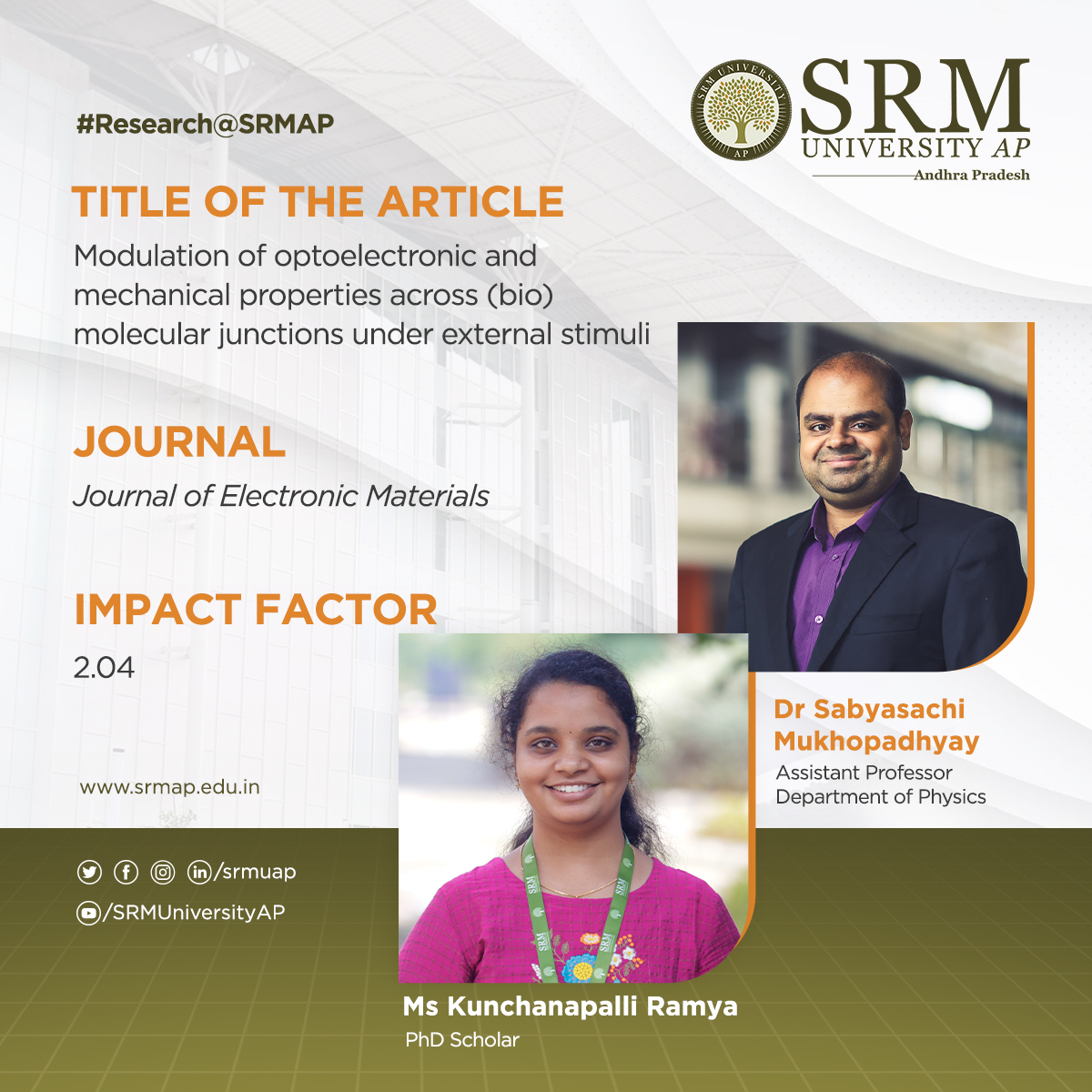 The latest research at the Department of Physics is investigating the charge transport across protein-based molecular junctions. Researchers envision fabricating bio- FETs which is useful in electronic devices as an alternative to Si- technology. Assistant Professor Dr Sabyasachi Mukhopadhyay and his PhD scholar Kunchanapalli Ramya published their paper Modulation of optoelectronic and mechanical properties across (bio) molecular junctions under external stimuli in the journal of Electronic Materials with an impact factor 2.04.
The latest research at the Department of Physics is investigating the charge transport across protein-based molecular junctions. Researchers envision fabricating bio- FETs which is useful in electronic devices as an alternative to Si- technology. Assistant Professor Dr Sabyasachi Mukhopadhyay and his PhD scholar Kunchanapalli Ramya published their paper Modulation of optoelectronic and mechanical properties across (bio) molecular junctions under external stimuli in the journal of Electronic Materials with an impact factor 2.04.Abstract
Molecular junctions are formed by wedging molecules between two metal electrodes. Besides the conventional parameters of the metal-molecule-metal junction, such as the work function of electrodes and the molecules’ energy gap, molecule-electrode electronic coupling strength also plays a vital role in modulating the electronic properties of the molecular junction under external stimuli. We have also calculated several transport parameters which play a crucial role in finding the origin of conductance modulation under the external stimuli. We could find that before particular humidity conditions, the modulation in the conductance is due to the variation in coupling strength, which is due to the modulation in the electrostatic environment of retinal chromophores of protein by changing the structure of protein under various external stimuli.
Researchers have explored the external stimuli (illumination, force, and humidity conditions) effect on charge transport across bacteriorhodopsin-based molecular junctions. Their future research plans include bio- FET fabrication with the protein reported and studying the transistor characteristics across it.
Continue reading →

